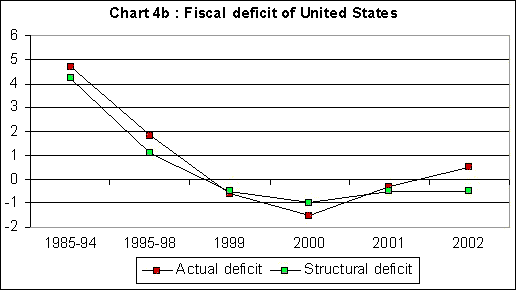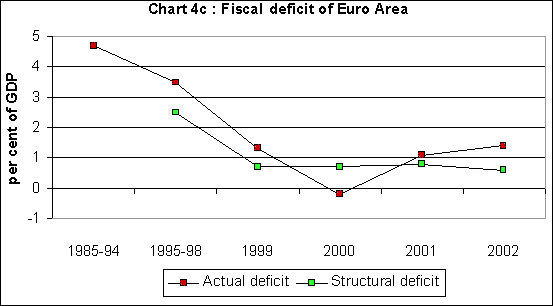The
European Union was supposed to be recovering from 2000, but the past
yearís growth performance was once again lower, suggesting that the
earlier growth impetus, such as it was, was not sufficient to raise the
dynamism in the European economy. Both the IMF and the OECD estimates
suggest a further deterioration in aggregate growth performance of the
European Union in the coming year.
The
Japanese economy is currently in the weakest position of all the major
capitalist economies. Clearly this economy is in the grip of a classic
deflation, with low output, falling prices and poor expectations leading
to declining levels of investment.
The
Japanese governmentís own forecasts show that the economy will not
grow at all in the fiscal year starting in April, with unemployment
continuing to rise, to nearly 6 per cent. In
2001, prices in Japan fell for the third year in a row, which is
unprecedented for a major industrial economy since the 1930s.
Furthermore, net export performance has also worsened. There was a 38
per cent fall in the Japanese trade surplus for 2001, the largest fall
since 1970 and the third successive year of decline.
Accompanying
all this has been a strange process of convergence
of unemployment rates, as evident from Chart 3. While
Japan had always been considered a low unemployment
economy largely for structural reasons, it was argued
that more ''flexible'' labour market combined with greater
economic dynamism made rates of open unemployment
much lower in the US than in Western Europe. But Chart
3 shows that over the recent past, while rates of
unemployment have been declining in Europe (despite
less impressive output growth) they have been rising
in both the US and Japan.

Chart
3 >> Click
to Enlarge
What
is the prognosis, given such a combination of forces in the major
economies ? Most analysts have been pessimistic about the prospects of
an early recovery, despite the Bush administrationís efforts to
provide a fiscal stimulus through large tax cuts and increased spending,
especially after September 11. The pessimism ranges from perceptions
that the size of the fiscal stimulus is simply not enough to provide the
kind of stimulus which is required, to the argument that it has been
largely oriented towards tax cuts for large corporations and the wealthy
along with increased military spending, neither of which have large
multiplier effects.
Another
view is expressed in a report issued in December 2001 by the Levy
Economics Institute, written by economists Wynne Godley and Alex
Izurieta. This argued that the current recession in the US is different
from earlier recessions because of large structural imbalances in the US
economy. According to them, ''the United States should now be prepared
for one of the deepest and most intractable recessions of the post-World
War II period, with no natural process of recovery in sight unless a
large and complex orientation of policy occurs both here and in the rest
of the world. The grounds for reaching this sombre conclusion are that
very large structural imbalances, with unique characteristics, have been
allowed to develop. These imbalances were always bound to unravel, and
it now looks as though the unraveling is well under way.''
In
Japan, deflation currently poses the greatest threat.
Not only have prices been falling over the past three years, the
rate of decline has been accelerating. Falling prices raise the real
level of interest, which explains why the very loose monetary policy
with historically low nominal interest rates has not implied falling
real rates of interest, This is the classic ''liquidity trap''
situation. High real rates of interest in a depressed real economy
increase the debt burden on both the private and public sectors to
potentially unsustainable levels. Over the past decade, the ratio of
gross public debt to GDP in Japan has increased from 61 percent to 131
percent, which is now the highest level for any OECD country. If debt
levels keep rising in this manner, it is possible that this may lead to
a collapse in public confidence in such debt, which in turn can even
lead to an Argentina-like crisis with soaring interest rates, high
inflation and outright default.
This
means that the attempt to explain the Japanese economic conundrum in
terms of a bloated and opaque banking sector completely misses the
point, since it is the macroeconomic conditions which are creating the
problems in individual banks as well. Certainly it is the case that in
an economy that is already burdened with vast post-bubble debt and a
heavy burden of non-performing loans held by the banking system, falling
prices and consequently rising real interest rates could result in a
spiral of mass bankruptcy, financial contraction and deepening
recession.
So
far the rest of the developed world has tried to ignore the magnitude of
the Japanese economic quagmire, and certainly has not provided any
meaningful assistance. But there can be significant international
implications if the problems get worse, which they seem likely to do at
present. Japanese capital has financed a large portion of the US
international debt. So an implosion on the Tokyo financial markets,
leading to the calling in of funds from the rest of the world, would
have major consequences for the world economy. At the very least this
would certainly prevent a rapid recovery in US financial markets, but it
could have even more devastating financial effects.
Policy
choices : The fiscal stance
One
of the more destructive economic consequences of the downfall of
Keynesianism in mainstream policy discussion has been the conscious
rejection of the fiscal stance as a major means of changing levels of
economic activity. One of the more blatant examples of this has been in
the case of the European Union, in which the Growth and Stability Pact
of the Maastricht Agreement explicitly restricted the ability of member
states to use fiscal deficits to reduce levels of excess capacity and
unemployment.
Nevertheless
it is true that the conditions for using fiscal policy in this manner
have changed significantly over the past decade, partly because of the
cross-border mobility of finance, which can play havoc with domestic
attempts to reflate economies, and partly because of certain other
processes. In fact, what is remarkable about the period since the
mid-1990s in particular, is the very different effects that fiscal
policy have had on particular economies, often completely contrary to
received wisdom.
Consider
the evidence presented in Charts 4a to 4d. The first point to not is how
the fiscal deficits have been declining quite rapidly as shares of GDP
in all the advanced countries taken as a group, to very low levels. In
fact, in terms of structural deficit (that is, accounting for the fact
that fiscal deficits move with business cycles, increasing in slumps and
declining in booms), the fiscal deficit in the major advanced economies
was less than 2 per cent of GDP in the latter half of the 1990s and has
been less than 1 per cent thereafter.
In the
United States, the boom was originally led by large
increases in government spending combined with tax
cuts. In the mid-1990s, however, the US, despite being
the country with the international reserve currency,
chose to curtail its fiscal deficits initially. And
when the US government was confronted with surpluses
in the course of the boom triggered by private spending,
it chose to hand over some part of those surpluses
to the private sector in the form of tax cuts. As
Chart 4b shows, since 1999 the US government budget
has been in surplus (negative deficit indicates surplus).

Chart
4a >> Click to Enlarge

Chart
4b >> Click
to Enlarge

Chart
4c >> Click
to Enlarge

Chart
4d >> Click
to Enlarge

